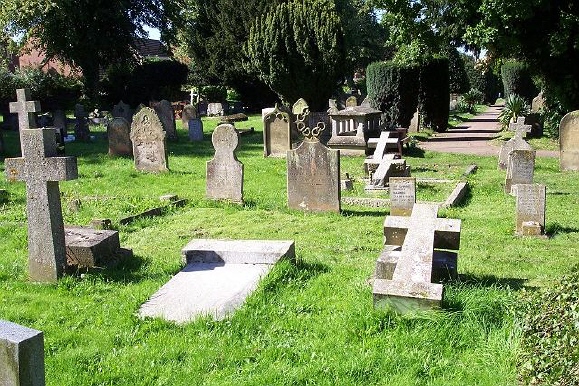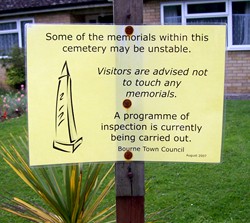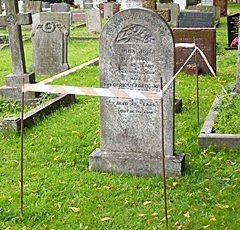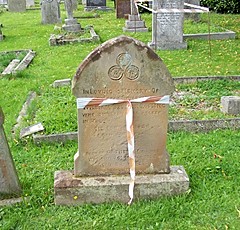|
The town cemetery
headstone survey

The painstaking task of checking the
stability of tombstones in the town cemetery began in the spring of 2004
to ensure that they are safe and unlikely to fall on unsuspecting
visitors.
The survey is being undertaken by Bourne Town Council under the Local
Authorities Cemetery Order of 1977 after concerns were raised by the
Health and Safety Executive that many memorials were in danger of causing
accidents, especially to children, and indeed some have already occurred
elsewhere. There have been a number of deaths and injuries over the past
five years caused by falling headstones, including one at Harrogate in
Yorkshire where a six-year-old boy was killed in July 2000.
Each headstone is being carefully assessed, usually by a simple hand test
to check for the movement of the memorial although some local authorities,
such as Sheffield City Council, are using an instrument called a Topple
Tester, a hand-held device which measures the pressure required to cause
movement in the headstone up to a maximum of 35 kg. If movement is
detected, then burial registers are checked for the present grave owner
and a current address, a difficult task because not all cemetery records
include this information, but attempts are then made to contact them to
provide an opportunity for remedial work to be carried out at their
expense. Otherwise, the headstones are laid flat.
Surveys have already caused anger and resentment in some parts of Britain,
especially where local authorities have begun laying unstable memorials
flat without consulting bereaved families. In October 2003, relatives of
130 people buried at Caldicot Cemetery in Monmouthshire were upset to find
that their memorials had been removed as unsafe without notification and
many arrived at the cemetery to find that the headstones had been placed
flat on the ground without their knowledge or agreement and at Torquay in
Devon, contractors appointed by Torbay Council to assess the safety risks
were accused of being over zealous after relatives were given only 14 days
to make dangerous headstones safe. Elsewhere, yellow warning markers and
even brightly coloured plastic covers have been put on dangerous
headstones pending the completion of safety work.
Some stones in the town cemetery at Bourne have already been laid flat by
maintenance staff when they appeared to become dangerous in years past but
the present survey will be far more thorough. The amount of work involved
can be assessed by the number of gravestones and although no accurate
figure is available, over 10,000 people are buried there and around 70%
have a stone memorial, although those erected recently, especially in the
new part of the cemetery, will cause no problems because of changing
materials and specifications.
It is those stone memorials erected in earlier times, from the opening of
the cemetery in 1855 and over the next 100 years, that are most likely to
present problems. Graves tend to subside with the years and therefore the
heavier memorials, especially those made of stone, soon lean and are in
danger of falling. It is these that will be identified by the survey.
The town council appointed a working party to assess the situation last
year and it recommended that £10,000 be set aside during the 2004-05
financial year to pay for carrying out remedial work on unstable
headstones but after a lengthy debate, councillors decided that relatives
who are still alive should foot the bill, otherwise they will be laid flat
with the inscriptions uppermost to ensure that visitors can still identity
occupants of the burial spaces.
|
WARNING TO VISITORS
There are fears that visitors might not be
aware of the survey or of the unstable condition of many tombstones
and in order to alert them, a warning notice has been posted near to
the entrance. |
 |
It is debatable whether these surveys are really necessary and, more
importantly, whether tombstones should be laid flat because they have
caused problems elsewhere. The incidents that have occurred all involve
children who most likely had no right to be there in the first place
because cemeteries are not playgrounds. I have heard of accidents in which
youngsters have been injured swinging from lampposts but no one ever
suggested that they should be removed from the streets. A far more
acceptable solution would be to keep children out, unless accompanied by
an adult who would be responsible for them.
The Health and Safety Executive, which is behind this particular bit of
nonsense, has been ridiculed in the past for some of its sillier excesses
but once an organisation has been appointed by government to fulfil a
role, it will continue to do that even after its sell by date has expired
because jobs are at stake and they eventually become more important than
the work in hand. There is a further consideration in that the laying flat
of ancient tombstones will change the appearance of our graveyards forever
and not for the better. Those who come after may well regard it as a form
of officially sanctioned vandalism and wonder whatever we were about.
In February 2008, volunteers co-ordinated
by Lincolnshire County Council were busy at work in the cemetery, tidying
graves and making headstones safe wherever possible, a project that is
doing much to improve its appearance.
|
 |
The effects of the survey were becoming evident
in 2008 when many tombstones had been marked with a warning tape
that they might be a danger to visitors and required attention.
|
 |
REVISED SEPTEMBER 2008
Return to The
Town Cemetery

Go to:
Main Index Villages
Index
|



